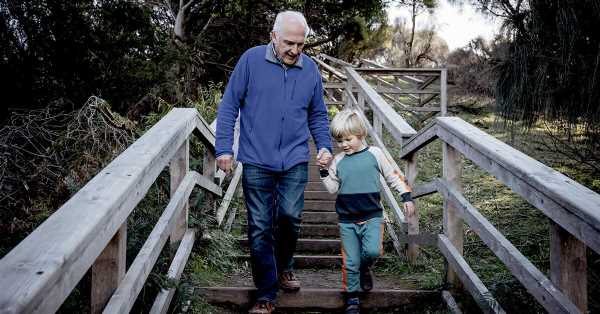
- Physical activity can slow the aging process and is associated with a reduced risk of all-cause mortality in older adults.
- Conversely, chronic illness and age-related changes in exercise capacity can hinder the ability of older individuals to achieve the recommended physical activity levels.
- A new study involving individuals ages 85 years and older shows that walking at least 1 hour per week could reduce the risk of all-cause and cardiovascular mortality.
- The results are consistent with current physical activity guidelines that recommend that older individuals unable to engage in moderate-intensity physical exercise should engage in physical activity as permitted by their abilities.
Physical activity can promote healthy aging, but chronic conditions and age-related decline in exercise capacity often prevent older adults from engaging in moderate or vigorous physical activity as recommended by health guidelines.
A new study shows that individuals ages 85 and older who walked for at least 1 hour a week had a lower risk of all-cause mortality and cardiovascular disease than their peers who did not engage in physical activity.
The study’s co-author, Dr. Moo-Nyun Jin of Inje University, South Korea, said in a press release:
“Identifying the minimum amount of exercise that can benefit the oldest old is an important goal since recommended activity levels can be difficult to achieve. Our study indicates that walking even just one hour every week is advantageous to those [ages] 85 years and older compared to being completely inactive. The take-home message is to keep walking throughout life.”
The research will be presented at the European Society of Cardiology Congress 2022 in late August.
Aging and physical activity
Aging is associated with an increased risk of chronic health conditions and a decline in physical and cognitive abilities.
The number of individuals ages 65 years and older across the globe was around 1 billion in 2019, which is expected to more than double by 2050. This increase in the aging population reflects an increase in life expectancy but raises concerns about healthy aging.
Physical activity can reduce the risk of chronic illness, such as cardiovascular diseases and diabetes, and can slow down the impact of aging on physical and cognitive decline. Moreover, physical activity can help preserve flexibility and balance in older individuals and enable them to function independently.
Consistent with these effects, a recent observational study including older adults shows that physical activity levels are negatively correlated with the risk of all-cause mortality.
However, chronic illness and age-related decline in muscle strength can, in turn, limit the ability of older adults to engage in physical activity. Moreover, sedentary behavior also increases with aging.
Current recommendations for physical activity
Research from 2016 suggests that a majority of older adults over the age of 65 in the United States do not meet the physical activity recommendations.
The current physical activity guidelines for all adults in the U.S. recommend at least 150 minutes of moderate-intensity aerobic activity such as brisk walking or 75 minutes of vigorous-intensity aerobic activity such as running per week.
The guidelines also recommend 2 days of muscle-strengthening exercises, such as lifting weights or body-weight exercises.
Recommendations for older adults emphasize the incorporation of a mixed regime involving aerobic exercise, resistance training, and balance training to avoid falls.
The physical activity guidelines also recommend that older adults who are unable to engage in moderate-intensity physical exercise should engage in physical activity according to their abilities after consulting a healthcare professional.
How walking benefits health and longevity
The authors of the present study examined whether walking could reduce the risk of all-cause mortality and mortality due to cardiovascular disease in individuals ages 85 years and older.
The study included data from 7,047 individuals ages 85 years or older residing in South Korea. The researchers used a questionnaire to assess the amount of time spent per week by the participants engaging in slow walking, moderate-intensity, or vigorous-intensity physical activity.
The researchers found that about 42% of individuals ages 85 years and older regularly walked, whereas around 26% engaged in either moderate or vigorous physical activity.
Moreover, about one-third of all individuals who walked regularly also engaged in moderate or vigorous physical activity. Notably, fewer than 8% of the older adults achieved the recommended levels of moderate-vigorous intensity physical activity.
The researchers found that individuals who walked for at least 1 hour a week had a lower risk of all-cause and cardiovascular mortality than inactive individuals.
The lower risk of all-cause and cardiovascular mortality was observed in older adults who walked for at least an hour, regardless of whether they did or did not engage in moderate-to-vigorous intensity physical activity in addition to walking.
Possible limitations of the new research
Dr. Maria Fiatarone Singh, a geriatrician at the University of Sydney, noted that the study findings are only correlational.
Dr. Singh told Medical News Today: “This is an observational study and not an experimental study — so it means causality cannot be presumed. In other words, it is possible that diseases resulting in mortality prevented people from walking rather than the other way around. The only experimental study with mortality as an outcome is the Generation100 study from Norway.”
Dr. Singh also noted that walking might not be suitable for older adults with disabilities or chronic conditions.
“Although walking seems easy and safe, people who are frail, sarcopenic, osteoporotic, or [prone to falls] are recommended to do resistance and balance training rather than walking, and add walking later when they are able to do it safely.”
– Dr. Maria Fiatarone Singh, geriatrician at the University of Sydney
Source: Read Full Article
